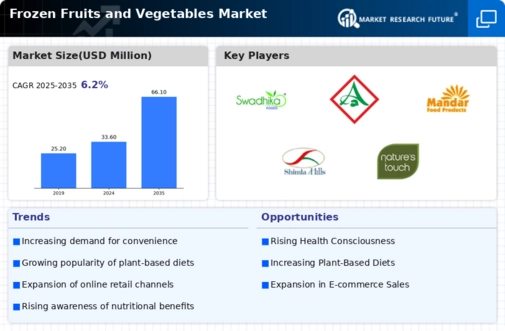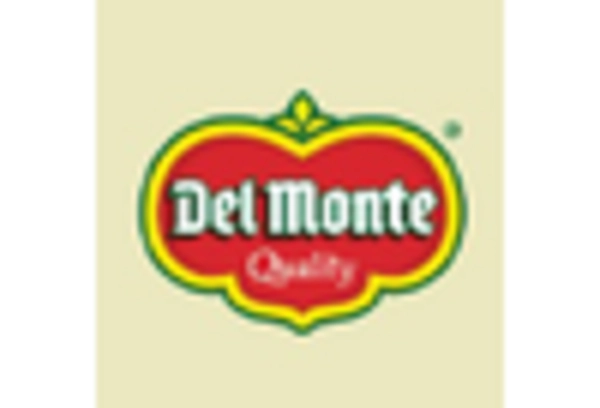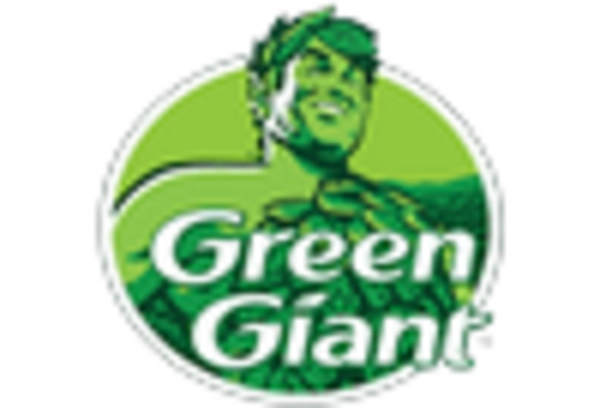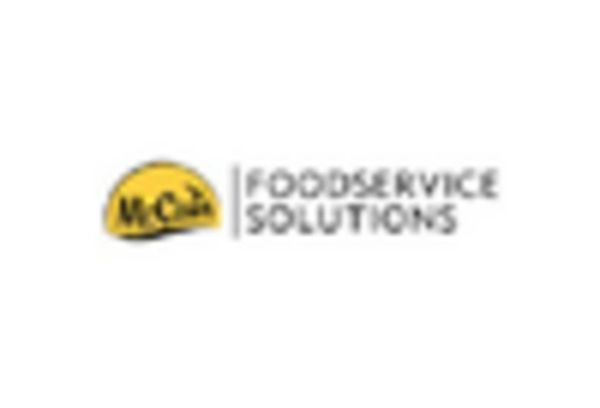-
EXECUTIVE SUMMARY 15
-
MARKET ATTRACTIVENESS ANALYSIS 16
- GLOBAL FROZEN FRUITS AND VEGETABLES MARKET BY TYPE 16
- GLOBAL FROZEN FRUITS AND VEGETABLES MARKET BY CATEGORY 17
- GLOBAL FROZEN FRUITS AND VEGETABLES MARKET, BY FORM 18
- GLOBAL FROZEN FRUITS AND VEGETABLES MARKET BY DISTRIBUTION CHANNEL 19
- GLOBAL FROZEN FRUITS AND VEGETABLES MARKET BY REGION 20
-
MARKET INTRODUCTION 21
-
DEFINITION 21
-
SCOPE OF THE STUDY 21
-
RESEARCH OBJECTIVE 21
-
MARKET STRUCTURE 22
-
RESEARCH METHODOLOGY 23
-
DATA MINING 23
-
SECONDARY RESEARCH 24
-
PRIMARY RESEARCH 24
- PRIMARY INTERVIEWS AND INFORMATION GATHERING PROCESS 25
- BREAKDOWN OF PRIMARY RESPONDENTS 25
-
RESEARCH METHODOLOGY FOR MARKET SIZE ESTIMATION 27
- BOTTOM-UP APPROACH 28
- TOP-DOWN APPROACH 28
-
DATA VALIDATION 29
-
ASSUMPTIONS & LIMITATIONS 29
-
MARKET DYNAMICS 30
-
INTRODUCTION 30
-
DRIVERS 32
- INCREASING AWARENESS OF HEALTH BENEFITS 32
- RISING DEMAND FOR PLANT-BASED DIETS 32
- YEAR-ROUND AVAILABILITY OF FROZEN FRUITS AND VEGETABLES 33
-
RESTRAINT 34
- PERCEIVED QUALITY CONCERNS AMONG CONSUMERS 34
- FLUCTUATING RAW MATERIAL PRICES 35
-
OPPORTUNITIES 36
- INNOVATIVE PROCESSING TECHNIQUES 36
- IMPROVED SUPPLY CHAIN AND DISTRIBUTION 36
- INNOVATIVE PROCESSING TECHNIQUES 37
-
CHALLENGES 37
- COMPETITION FROM FRESH ALTERNATIVES 37
-
MARKET FACTOR ANALYSIS 38
-
VALUE CHAIN ANALYSIS 38
- RAW MATERIAL SOURCING 38
- PROCESSING 39
- FREEZING TECHNOLOGY 39
- PACKAGING 40
- DISTRIBUTION 40
- RETAIL AND CONSUMER PURCHASE 41
- CONSUMER USAGE 41
-
SUPPLY CHAIN ANALYSIS 42
- RAW MATERIAL SUPPLIERS 43
- PROCESSORS 43
- FREEZING TECHNOLOGY PROVIDERS 44
- PACKAGING MANUFACTURERS 44
- LOGISTICS PROVIDERS 45
- RETAIL 45
- CONSUMERS 46
-
PORTER’S FIVE FORCES MODEL 47
- BARGAINING POWER OF SUPPLIERS 47
- BARGAINING POWER OF BUYERS 48
- THREAT OF NEW ENTRANTS 48
- THREAT OF SUBSTITUTES 49
- INTENSITY OF RIVALRY 49
-
IMPACT OF CORONAVIRUS OUTBREAK ON GLOBAL MARKET 49
- IMPACT ON PRODUCTION 50
- IMPACT ON SUPPLY CHAIN 50
- IMPACT ON PRICING 51
- IMPACT ON CONSUMER DEMAND 51
- IMPACT ON ONLINE VS. OFFLINE SALES 52
-
GLOBAL FROZEN FRUITS AND VEGETABLES MARKET, BY TYPE 53
-
INTRODUCTION 53
-
FRUITS 54
- AVOCADO 55
- STRAWBERRIES 56
- BLUEBERRIES 56
- MELONS 57
- CITRUS FRUITS 57
- BERRIES 58
- MANGO 58
- KIWI 59
- OTHERS 59
-
VEGETABLES 60
- PEAS 61
- MUSHROOM 61
- CARROT 62
- BEANS 62
- OTHERS 63
-
GLOBAL FROZEN FRUITS AND VEGETABLES MARKET, BY CATEGORY 64
-
INTRODUCTION 64
-
ORGANIC 65
-
CONVENTIONAL 66
-
GLOBAL FROZEN FRUITS AND VEGETABLES MARKET, BY FORM 67
-
INTRODUCTION 67
-
WHOLE 68
-
SLICED 68
-
CUBED 69
-
GLOBAL FROZEN FRUITS AND VEGETABLES MARKET, BY DISTRIBUTION CHANNEL 70
-
INTRODUCTION 70
-
SUPERMARKETS & HYPERMARKETS 71
-
CONVENIENCE STORES 72
-
SPECIALTY STORES 72
-
ONLINE 73
-
OTHERS 74
-
GLOBAL FROZEN FRUITS AND VEGETABLES MARKET, BY REGION 75
-
INTRODUCTION 75
-
NORTH AMERICA 76
- US 79
- CANADA 82
- MEXICO 85
-
EUROPE 88
- GERMANY 92
- FRANCE 94
- UK 97
- ITALY 100
- SPAIN 103
- REST OF EUROPE 106
-
ASIA PACIFIC 109
- CHINA 113
- JAPAN 116
- INDIA 118
- AUSTRALIA AND NEWZEALAND 121
- REST OF ASIA PACIFIC 124
-
ROW 127
- SOUTH AMERICA 131
- MIDDLE EAST 133
- AFRICA 136
-
COMPETITIVE LANDSCAPE 139
-
COMPETITIVE OVERVIEW 139
-
COMPETITIVE BENCHMARKING 140
-
MARKET SHARE ANALYSIS 141
-
COMPANY PROFILES 142
-
SUYOG FOOD PRODUCTS 142
- COMPANY OVERVIEW 142
- PRODUCTS OFFERED 143
- SWOT ANALYSIS 144
- KEY STRATEGY 144
-
SWADHIKA FOODS 145
- COMPANY OVERVIEW 145
- PRODUCTS OFFERED 145
- SWOT ANALYSIS 146
- KEY STRATEGY 146
-
ROYAL FOODSTUFFS 147
- COMPANY OVERVIEW 147
- PRODUCTS OFFERED 147
- SWOT ANALYSIS 148
- KEY STRATEGY 148
-
CHINA KUNYU INDUSTRIAL CO LTD 149
- COMPANY OVERVIEW 149
- PRODUCTS OFFERED 149
- SWOT ANALYSIS 150
- KEY STRATEGY 150
-
XIAMEN SINOFROST CO.,LTD 151
- COMPANY OVERVIEW 151
- PRODUCTS OFFERED 151
- KEY DEVELOPMENTS 154
- SWOT ANALYSIS 155
- KEY STRATEGY 155
-
GHOUSIA FOOD PRODUCTS PVT LTD 156
- COMPANY OVERVIEW 156
- PRODUCTS OFFERED 157
- KEY DEVELOPMENTS 157
- SWOT ANALYSIS 158
- KEY STRATEGY 158
-
MANDAR FOOD PRODUCTS 159
- COMPANY OVERVIEW 159
- PRODUCTS OFFERED 159
- SWOT ANALYSIS 161
- KEY STRATEGY 161
-
TANVI FOODS (INDIA) LTD 162
- COMPANY OVERVIEW 162
- FINANCIAL OVERVIEW 162
- PRODUCTS OFFERED 163
- KEY DEVELOPMENTS 163
- SWOT ANALYSIS 164
- KEY STRATEGY 164
-
SHIMLAHILLS 165
- COMPANY OVERVIEW 165
- PRODUCTS OFFERED 165
- SWOT ANALYSIS 166
- KEY STRATEGY 166
-
NATURE’S TOUCH 167
- COMPANY OVERVIEW 167
- PRODUCTS OFFERED 167
- SWOT ANALYSIS 168
- KEY STRATEGY 168
-
-
LIST OF TABLES
-
MARKET SYNOPSIS 15
-
LIST OF ASSUMPTIONS 29
-
GLOBAL FROZEN FRUITS AND VEGETABLES MARKET, BY TYPE, 2020-2032 (USD MILLION) 54
-
GLOBAL FROZEN FRUITS AND VEGETABLES MARKET, BY FRUITS, 2020-2032 (USD MILLION) 55
-
GLOBAL FROZEN FRUITS AND VEGETABLES MARKET, BY VEGETABLES, 2020-2032 (USD MILLION) 60
-
GLOBAL FROZEN FRUITS AND VEGETABLES MARKET, BY CATEGORY, 2020-2032 (USD MILLION) 64
-
GLOBAL FROZEN FRUITS AND VEGETABLES MARKET, BY FORM, 2020-2032 (USD MILLION) 67
-
GLOBAL FROZEN FRUITS AND VEGETABLES MARKET, BY DISTRIBUTION CHANNEL, 2020-2032 (USD MILLION) 71
-
GLOBAL FROZEN FRUITS AND VEGETABLES MARKET, BY REGION, 2020-2032 (USD MILLION) 75
-
NORTH AMERICA FROZEN FRUITS AND VEGETABLES MARKET, BY TYPE, 2020-2032 (USD MILLION) 77
-
NORTH AMERICA FROZEN FRUITS AND VEGETABLES MARKET, BY FRUITS, 2020-2032 (USD MILLION) 77
-
NORTH AMERICA FROZEN FRUITS AND VEGETABLES MARKET, BY VEGETABLES, 2020-2032 (USD MILLION) 77
-
NORTH AMERICA FROZEN FRUITS AND VEGETABLES MARKET, BY CATEGORY, 2020-2032 (USD MILLION) 78
-
NORTH AMERICA FROZEN FRUITS AND VEGETABLES MARKET, BY FORM, 2020-2032 (USD MILLION) 78
-
NORTH AMERICA FROZEN FRUITS AND VEGETABLES MARKET, BY DISTRIBUTION CHANNEL, 2020-2032 (USD MILLION) 78
-
US FROZEN FRUITS AND VEGETABLES MARKET, BY TYPE, 2020-2032 (USD MILLION) 79
-
US FROZEN FRUITS AND VEGETABLES MARKET, BY FRUITS, 2020-2032 (USD MILLION) 80
-
US FROZEN FRUITS AND VEGETABLES MARKET, BY VEGETABLES, 2020-2032 (USD MILLION) 80
-
US FROZEN FRUITS AND VEGETABLES MARKET, BY CATEGORY, 2020-2032 (USD MILLION) 81
-
US FROZEN FRUITS AND VEGETABLES MARKET, BY FORM, 2020-2032 (USD MILLION) 81
-
US FROZEN FRUITS AND VEGETABLES MARKET, BY DISTRIBUTION CHANNEL, 2020-2032 (USD MILLION) 81
-
CANADA FROZEN FRUITS AND VEGETABLES MARKET, BY TYPE, 2020-2032 (USD MILLION) 82
-
CANADA FROZEN FRUITS AND VEGETABLES MARKET, BY FRUITS, 2020-2032 (USD MILLION) 83
-
CANADA FROZEN FRUITS AND VEGETABLES MARKET, BY VEGETABLES, 2020-2032 (USD MILLION) 83
-
CANADA FROZEN FRUITS AND VEGETABLES MARKET, BY CATEGORY, 2020-2032 (USD MILLION) 84
-
CANADA FROZEN FRUITS AND VEGETABLES MARKET, BY FORM, 2020-2032 (USD MILLION) 84
-
CANADA FROZEN FRUITS AND VEGETABLES MARKET, BY DISTRIBUTION CHANNEL, 2020-2032 (USD MILLION) 84
-
MEXICO FROZEN FRUITS AND VEGETABLES MARKET, BY TYPE, 2020-2032 (USD MILLION) 85
-
MEXICO FROZEN FRUITS AND VEGETABLES MARKET, BY FRUITS, 2020-2032 (USD MILLION) 86
-
MEXICO FROZEN FRUITS AND VEGETABLES MARKET, BY VEGETABLES, 2020-2032 (USD MILLION) 86
-
MEXICO FROZEN FRUITS AND VEGETABLES MARKET, BY CATEGORY, 2020-2032 (USD MILLION) 87
-
MEXICO FROZEN FRUITS AND VEGETABLES MARKET, BY FORM, 2020-2032 (USD MILLION) 87
-
MEXICO FROZEN FRUITS AND VEGETABLES MARKET, BY DISTRIBUTION CHANNEL, 2020-2032 (USD MILLION) 87
-
EUROPE: FROZEN FRUITS AND VEGETABLES MARKET, BY COUNTRY, 2020 TO 2032 (USD MILLION) 89
-
EUROPE FROZEN FRUITS AND VEGETABLES MARKET, BY TYPE, 2020-2032 (USD MILLION) 90
-
EUROPE FROZEN FRUITS AND VEGETABLES MARKET, BY FRUITS, 2020-2032 (USD MILLION) 90
-
EUROPE FROZEN FRUITS AND VEGETABLES MARKET, BY VEGETABLES, 2020-2032 (USD MILLION) 90
-
EUROPE FROZEN FRUITS AND VEGETABLES MARKET, BY CATEGORY, 2020-2032 (USD MILLION) 91
-
EUROPE FROZEN FRUITS AND VEGETABLES MARKET, BY FORM, 2020-2032 (USD MILLION) 91
-
EUROPE FROZEN FRUITS AND VEGETABLES MARKET, BY DISTRIBUTION CHANNEL, 2020-2032 (USD MILLION) 91
-
GERMANY FROZEN FRUITS AND VEGETABLES MARKET, BY TYPE, 2020-2032 (USD MILLION) 92
-
GERMANY FROZEN FRUITS AND VEGETABLES MARKET, BY FRUITS, 2020-2032 (USD MILLION) 93
-
GERMANY FROZEN FRUITS AND VEGETABLES MARKET, BY VEGETABLES, 2020-2032 (USD MILLION) 93
-
GERMANY FROZEN FRUITS AND VEGETABLES MARKET, BY CATEGORY, 2020-2032 (USD MILLION) 93
-
GERMANY FROZEN FRUITS AND VEGETABLES MARKET, BY FORM, 2020-2032 (USD MILLION) 94
-
GERMANY FROZEN FRUITS AND VEGETABLES MARKET, BY DISTRIBUTION CHANNEL, 2020-2032 (USD MILLION) 94
-
FRANCE FROZEN FRUITS AND VEGETABLES MARKET, BY TYPE, 2020-2032 (USD MILLION) 95
-
FRANCE FROZEN FRUITS AND VEGETABLES MARKET, BY FRUITS, 2020-2032 (USD MILLION) 95
-
FRANCE FROZEN FRUITS AND VEGETABLES MARKET, BY VEGETABLES, 2020-2032 (USD MILLION) 96
-
FRANCE FROZEN FRUITS AND VEGETABLES MARKET, BY CATEGORY, 2020-2032 (USD MILLION) 96
-
FRANCE FROZEN FRUITS AND VEGETABLES MARKET, BY FORM, 2020-2032 (USD MILLION) 96
-
FRANCE FROZEN FRUITS AND VEGETABLES MARKET, BY DISTRIBUTION CHANNEL, 2020-2032 (USD MILLION) 97
-
UK FROZEN FRUITS AND VEGETABLES MARKET, BY TYPE, 2020-2032 (USD MILLION) 98
-
UK FROZEN FRUITS AND VEGETABLES MARKET, BY FRUITS, 2020-2032 (USD MILLION) 98
-
UK FROZEN FRUITS AND VEGETABLES MARKET, BY VEGETABLES, 2020-2032 (USD MILLION) 98
-
UK FROZEN FRUITS AND VEGETABLES MARKET, BY CATEGORY, 2020-2032 (USD MILLION) 99
-
UK FROZEN FRUITS AND VEGETABLES MARKET, BY FORM, 2020-2032 (USD MILLION) 99
-
UK FROZEN FRUITS AND VEGETABLES MARKET, BY DISTRIBUTION CHANNEL, 2020-2032 (USD MILLION) 99
-
ITALY FROZEN FRUITS AND VEGETABLES MARKET, BY TYPE, 2020-2032 (USD MILLION) 100
-
ITALY FROZEN FRUITS AND VEGETABLES MARKET, BY FRUITS, 2020-2032 (USD MILLION) 101
-
ITALY FROZEN FRUITS AND VEGETABLES MARKET, BY VEGETABLES, 2020-2032 (USD MILLION) 101
-
ITALY FROZEN FRUITS AND VEGETABLES MARKET, BY CATEGORY, 2020-2032 (USD MILLION) 101
-
ITALY FROZEN FRUITS AND VEGETABLES MARKET, BY FORM, 2020-2032 (USD MILLION) 102
-
ITALY FROZEN FRUITS AND VEGETABLES MARKET, BY DISTRIBUTION CHANNEL, 2020-2032 (USD MILLION) 102
-
SPAIN FROZEN FRUITS AND VEGETABLES MARKET, BY TYPE, 2020-2032 (USD MILLION) 103
-
SPAIN FROZEN FRUITS AND VEGETABLES MARKET, BY FRUITS, 2020-2032 (USD MILLION) 104
-
SPAIN FROZEN FRUITS AND VEGETABLES MARKET, BY VEGETABLES, 2020-2032 (USD MILLION) 104
-
SPAIN FROZEN FRUITS AND VEGETABLES MARKET, BY CATEGORY, 2020-2032 (USD MILLION) 104
-
SPAIN FROZEN FRUITS AND VEGETABLES MARKET, BY FORM, 2020-2032 (USD MILLION) 105
-
SPAIN FROZEN FRUITS AND VEGETABLES MARKET, BY DISTRIBUTION CHANNEL, 2020-2032 (USD MILLION) 105
-
REST OF EUROPE FROZEN FRUITS AND VEGETABLES MARKET, BY TYPE, 2020-2032 (USD MILLION) 106
-
REST OF EUROPE FROZEN FRUITS AND VEGETABLES MARKET, BY FRUITS, 2020-2032 (USD MILLION) 107
-
REST OF EUROPE FROZEN FRUITS AND VEGETABLES MARKET, BY VEGETABLES, 2020-2032 (USD MILLION) 107
-
REST OF EUROPE FROZEN FRUITS AND VEGETABLES MARKET, BY CATEGORY, 2020-2032 (USD MILLION) 107
-
REST OF EUROPE FROZEN FRUITS AND VEGETABLES MARKET, BY FORM, 2020-2032 (USD MILLION) 108
-
REST OF EUROPE FROZEN FRUITS AND VEGETABLES MARKET, BY DISTRIBUTION CHANNEL, 2020-2032 (USD MILLION) 108
-
ASIA PACIFIC: FROZEN FRUITS AND VEGETABLES MARKET, BY COUNTRY, 2020 TO 2032 (USD MILLION) 110
-
ASIA PACIFIC FROZEN FRUITS AND VEGETABLES MARKET, BY TYPE, 2020-2032 (USD MILLION) 110
-
ASIA PACIFIC FROZEN FRUITS AND VEGETABLES MARKET, BY FRUITS, 2020-2032 (USD MILLION) 111
-
ASIA PACIFIC FROZEN FRUITS AND VEGETABLES MARKET, BY VEGETABLES, 2020-2032 (USD MILLION) 111
-
ASIA PACIFIC FROZEN FRUITS AND VEGETABLES MARKET, BY CATEGORY, 2020-2032 (USD MILLION) 112
-
ASIA PACIFIC FROZEN FRUITS AND VEGETABLES MARKET, BY FORM, 2020-2032 (USD MILLION) 112
-
ASIA PACIFIC FROZEN FRUITS AND VEGETABLES MARKET, BY DISTRIBUTION CHANNEL, 2020-2032 (USD MILLION) 112
-
CHINA FROZEN FRUITS AND VEGETABLES MARKET, BY TYPE, 2020-2032 (USD MILLION) 113
-
CHINA FROZEN FRUITS AND VEGETABLES MARKET, BY FRUITS, 2020-2032 (USD MILLION) 114
-
CHINA FROZEN FRUITS AND VEGETABLES MARKET, BY VEGETABLES, 2020-2032 (USD MILLION) 114
-
CHINA FROZEN FRUITS AND VEGETABLES MARKET, BY CATEGORY, 2020-2032 (USD MILLION) 115
-
CHINA FROZEN FRUITS AND VEGETABLES MARKET, BY FORM, 2020-2032 (USD MILLION) 115
-
CHINA FROZEN FRUITS AND VEGETABLES MARKET, BY DISTRIBUTION CHANNEL, 2020-2032 (USD MILLION) 115
-
JAPAN FROZEN FRUITS AND VEGETABLES MARKET, BY TYPE, 2020-2032 (USD MILLION) 116
-
JAPAN FROZEN FRUITS AND VEGETABLES MARKET, BY FRUITS, 2020-2032

















Leave a Comment